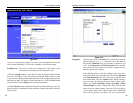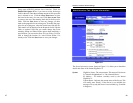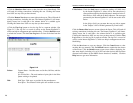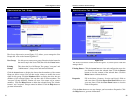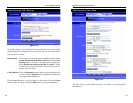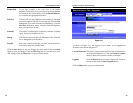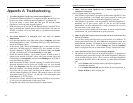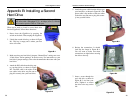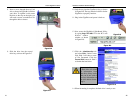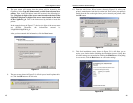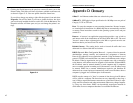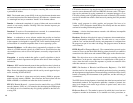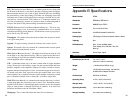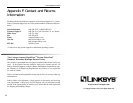
PrintServer - A hardware device that enables a printer to be located anywhere
in the network.
RJ-45 (Registered Jack-45) - A connector similar to a telephone connector that
holds up to eight wires, used for connecting Ethernet devices.
Router - Protocol-dependent device that connects subnetworks together.
Routers are useful in breaking down a very large network into smaller subnet-
works; they introduce longer delays and typically have much lower throughput
rates than bridges.
Server - Any computer whose function in a network is to provide user access to
files, printing, communications, and other services.
S.M.A.R.T. - (Self Monitoring Analysis and Reporting Technology) Hard drive
technology that reports its own degradation, enabling the operating system to
warn the user of potential failure.
Software - Instructions for the computer. A series of instructions that performs
a particular task is called a "program." The two major categories of software are
"system software" and "application software." System software is made up of
control programs such as the operating system and database management sys-
tem (DBMS). Application software is any program that processes data for the
user.
Static IP Address - A permanent IP address that is assigned to a node in an IP
or a TCP/IP network.
Storage - The semi-permanent or permanent holding place for digital data.
STP (Shielded Twisted Pair) Telephone wire that is wrapped in a metal sheath
to eliminate external interference.
Subnet Mask - The method used for splitting IP networks into a series of sub-
groups, or subnets. The mask is a binary pattern that is matched up with the IP
address to turn part of the host ID address field into a field for subnets.
Switch - 1. A data switch connects computing devices to host computers, allow-
ing a large number of devices to share a limited number of ports. 2. A device for
making, breaking, or changing the connections in an electrical circuit.
52
conventions relating to the format and timing of data transmission between two
computers that they must accept and use to be able to understand each other.
IP Address - In the most widely installed level of the Internet Protocol (IP)
today, an IP address is a 32-binary digit number that identifies each sender or
receiver of information that is sent in packet across the Internet. When you
request an HTML page or send e-mail, the Internet Protocol part of TCP/IP
includes your IP address in the message (actually, in each of the packets if more
than one is required) and sends it to the IP address that is obtained by looking
up the domain name in the Uniform Resource Locator you requested or in the
e-mail address you're sending a note to. At the other end, the recipient can see
the IP address of the Web page requestor or the e-mail sender and can respond
by sending another message using the IP address it received.
ISP (Internet Service Provider) - A company that provides individuals and com-
panies access to the Internet and other related services such as Web site build-
ing and virtual hosting.
LAN (Local Area Network) - A group of computers and associated devices that
share a common communications line and typically share the resources of a sin-
gle processor or server within a small geographic area (for example, within an
office building).
Mbps (Megabits per second) - One million bits per second; unit of measure-
ment for data transmission.
Network - A system that transmits any combination of voice, video and/or data
between users.
Network Mask - Also known as the "Subnet Mask".
NIC (Network Interface Card) - A board installed in a computer system, usual-
ly a PC, to provide network communication capabilities to and from that com-
puter system. Also called an adapter.
Packet - A unit of data routed between an origin and a destination in a network.
Plug-and-Play - The ability of a computer system to configure expansion
boards and other devices automatically without requiring the user to turn off the
system during installation.
51
EtherFast
®
Network Attached StorageInstant GigaDrive
TM
Series



